GIMP is a free open source video editor where persons can edit and manipulate their images. It consists of plugins and extensions to do about anything. The GIMP app provides filters, a special kind of tool designed to take an input layer or image, apply a mathematical algorithm to it, and return the input layer or image in a modified format.
What is Enhance filter in GIMP?
Enhance filters are used to compensate for image imperfections. These imperfections include dust particles, noise, interlaced frames, and insufficient sharpness. The Enhance filter menu provides several tools such as Antialias, Deinterlace, High Pass, Noise Reduction, Red Eye Removal, Symmetric Nearest Neighbor, Sharpen (Unsharp Mask), Despeckle, Destripe, NL Filter, and Wavelet-decompose.
GIMP uses filters to achieve various effects and has several categories namely: Blur filters, Enhance filters, Distort filters, Light and Shadow filters, Noise filters, Edge-Detect filters, Generic filters, combine filters, Artistic filter, Décor filter, Map filters, Rendering filters, Web filters, and Animation filters. To use filters in GIMP, you have to select the image with a select selection tool, then go to filters on the menu bar and choose a filter from the list.
How to use the Enhance filters in Gimp
We will explain the following topics:
- How to use the Antialias filter
- How to use the Deinterlace filter
- How to use the High Pass filter
- How to use the Noise reduction filter
- 5. How to use Red eye removal filter
- How to use Symmetric nearest neighbor filter
- How to use the Sharpen (Unsharp Mask) filter
- How to use the Despeckle filter
- How to use the Destripe filter
- How to use the NL Filter
- How to use Wavelet-decompose
1] How to use the Antialias filter in GIMP?
This Filter reduces alias effects using the Scale3X edge-extrapolation algorithm.
Open GIMP and have your image ready to use.
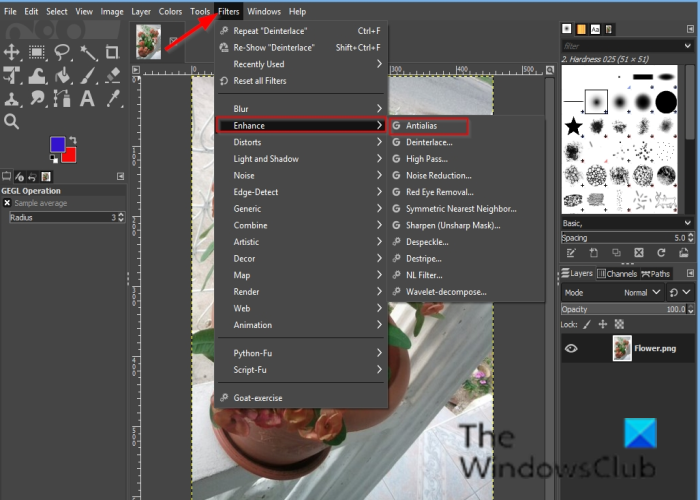
Click Filter on the menu bar, hover the cursor over Enhance, and select Antialias.
The effect applies to the image automatically.
2] How to use the Deinterlace filter in GIMP?
The Deinterlace Filter keeps only one of both images and replaces missing lines by a gradient between previous and following lines, especially if the images look blurred and stripped.
Click Filter on the menu bar, hover the cursor over Enhance, and select Deinterlace.
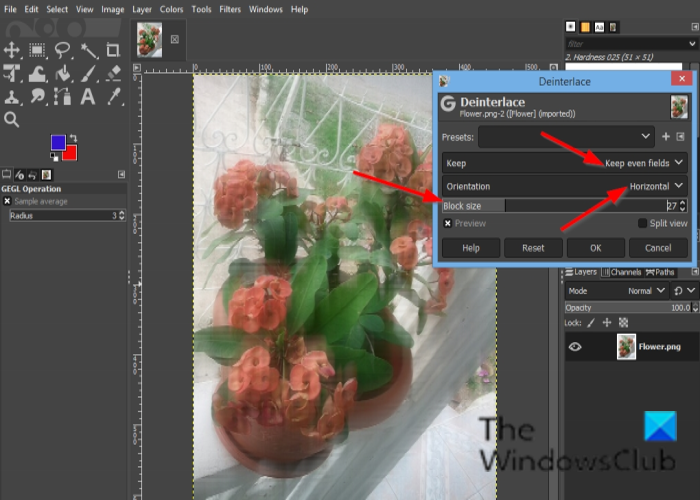
A Deinterlace dialog box will appear.
The dialog box contains the Keep even fields and Keep odd fields options; try both to see which is best for your photo.
You can also change the Orientation and use the Block size slider and input boxes.
Check the Preview checkbox to display the preview of your image.
Then click OK.
3] How to use the High Pass in GIMP?
Open image.
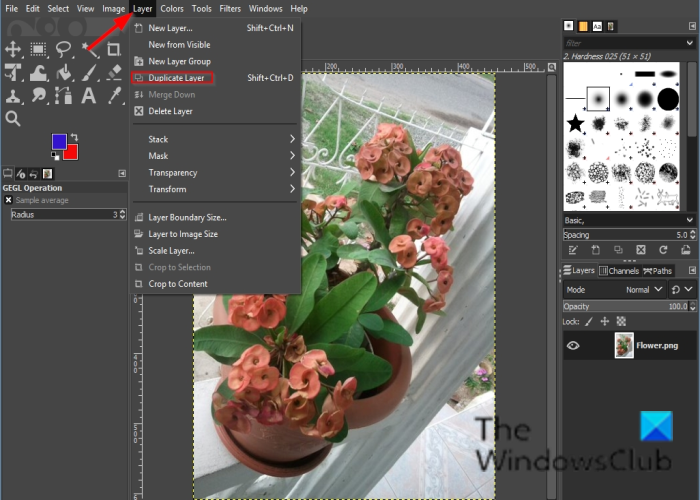
Click Layer on the menu bar and select Duplicate layer.
A copy of the layer will appear on the right of the GIMP interface.
Go to Filter on the menu bar, hover the cursor over Enhance, and select the High pass effect.
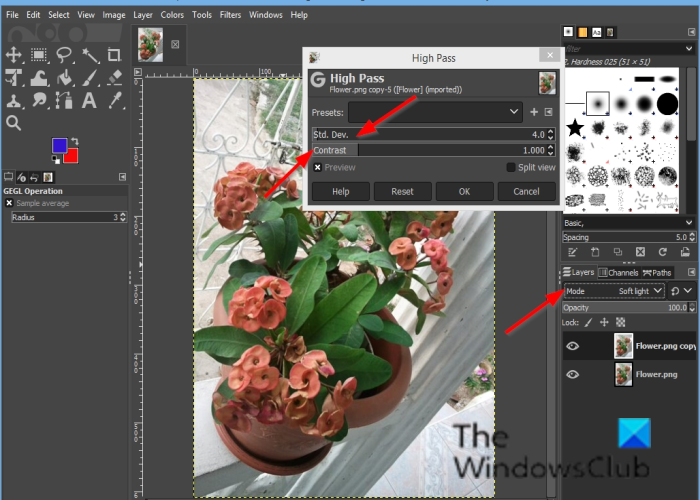
A High Pass dialog box will open.
On the right of the GIMP interface, change the mode to Soft light; You can also try Hard light.
Go back to the High Pass dialog box and customize the effect of the High Pass by clicking the input boxes of Std. Dev. and Contrast.
Then click OK.
4] How to use the Noise reduction filter in GIMP?
The Noise reduction filter is a simple GEGL filter to lessen noise.
Go to Filter on the menu bar, hover the cursor over Enhance, and select the Noise reduction effect.
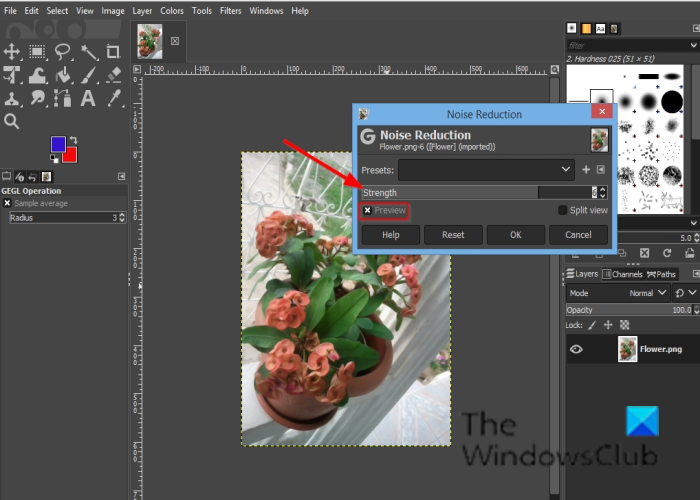
A Noise reduction dialog box will open.
In the dialog box, Strength lessens noise and increases the blur.
Check the Preview checkbox to display the preview of your image.
Then click OK.
5] How to use Red eye removal filter in GIMP?
The purpose of the Red eye filter is to remove red eyes from images.
Open image.
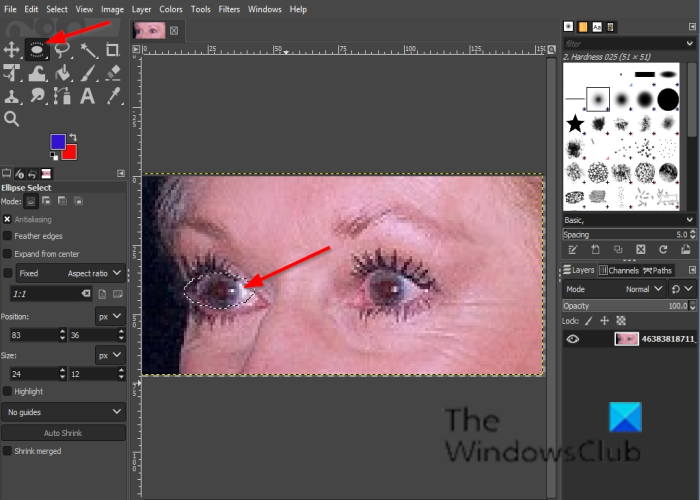
Click click either the Lasso select or Ellipse selection tool.
If you do not see the Eclipse tool, press the E key.
Draw the selection tool over the eyes in the image.
Click Filter on the menu bar, hover the cursor over Enhance, and select the Red eye removal effect.
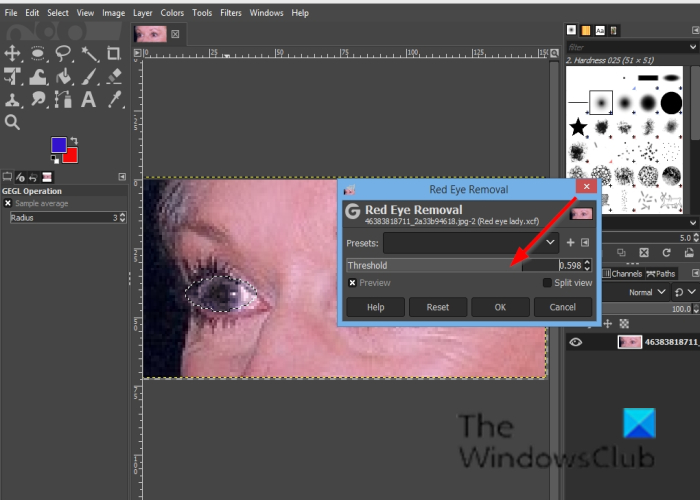
If you move the Threshold, the red color to remove will vary.
Click OK.
6] How to use Symmetric nearest neighbor filter in GIMP?
The Symmetric nearest neighbor effect blurs the image preserving edges.
Open image.
Click Filter on the menu bar, hover the cursor over Enhance, and select the Symmetric nearest neighbor effect.
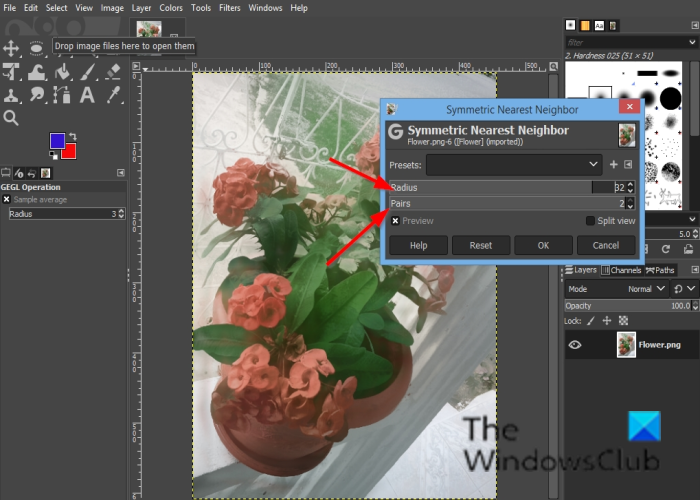
A Symmetric nearest neighbor dialog box will open.
In the dialog box, you can increase or decrease the radius and select 1 or 2 Pairs (a higher number preserves more acute features).
Then click OK.
7] How to use the Sharpen (Unsharp Mask) filterin GIMP?
Out-of-focus photographs and digitized images often need sharpness corrections.
Open image.
Duplicate the layer of the image.
Ensure it is on the copy you want to see the difference.
Click Filter on the menu bar, hover the cursor over Enhance, and select the Sharpen (Unsharp Mask) effect.
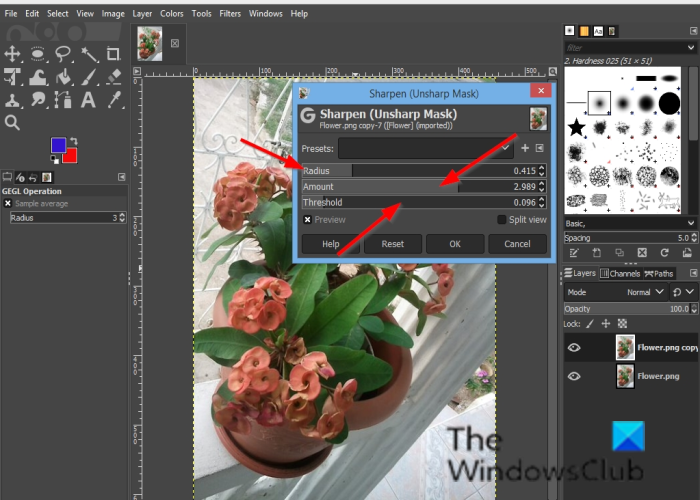
A Sharpen (Unsharp Mask) dialog box will open.
The Radius slider and input boxes allow the user to set how many pixels on either side of an edge will be affected by sharpening. High radius images allow a higher radius.
The Amount slider and input boxes set the strength of sharpening.
The Threshold slider and input boxes allow users to set the minimum difference in pixel values that indicates an edge where to apply to sharpen.
Then click OK.
8] How to use the Despeckle filter in GIMP?
The Despeckle filter removes small defects due to dust or scratches on a scanned image.
Open image.
Click Filter on the menu bar, hover the cursor over Enhance, and select the Despeckle effect.
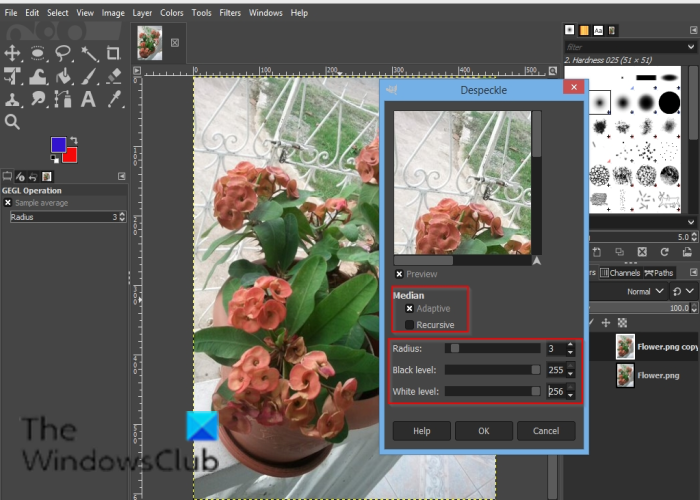
A Despeckle dialog box will open.
Under Median, there is the Adaptive and Recursive option.
The Adaptive option adapts the Radius to image or selection content by analyzing the histogram of the region around the target pixel. The adapted Radius will always be equal to or smaller than the specified Radius.
The Recursive option repeats filter action, which gets stronger.
The Radius sets the size of the action window from 1 to 20. This window moves over the image, and the color in it becomes smooth and eliminates the imperfections.
The Black level only includes pixels brighter than the set value in the histogram.
The White level only includes pixels darker than the set value in the histogram.
9] How to use the Destripe filter in GIMP?
The Destripe filter purpose is to remove vertical stripes due to poor quality scanners
Open image.
Click Filter on the menu bar, hover the cursor over Enhance, and select the Destripe effect.
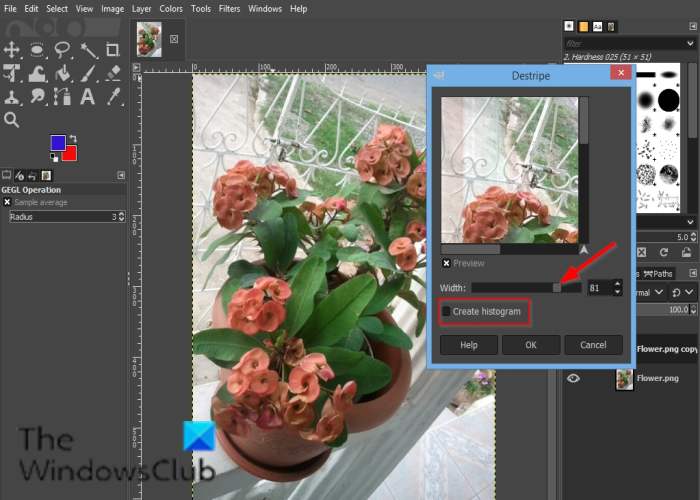
The Histogram is a black and white image showing the interference pattern more legibly.
The Width slider and input box allow users to set the “strength” of the filter.
10] How to use the NL Filter in GIMP?
The NL filter (Non-Linear) joins smoothing, despeckle and sharpen enhancement functions. It works on the whole layer, not on the selection.
Open image.
Click Filter on the menu bar, hover the cursor over Enhance, and select the NL effect.
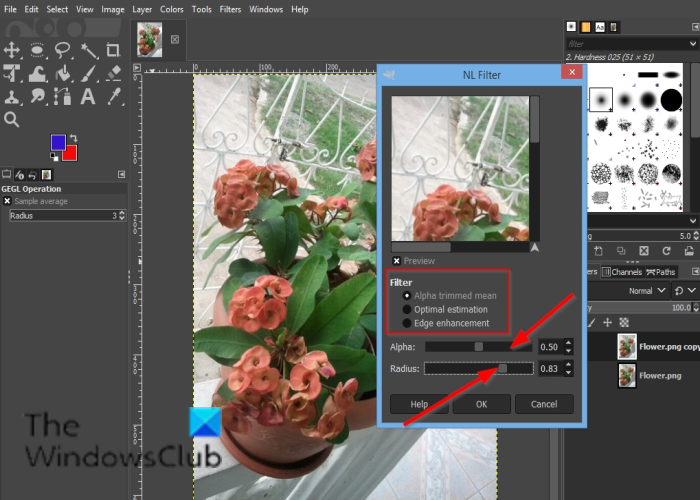
An NL dialog box will open.
Under Filter, you have three modes, namely: Alpha trimmed means, Optimal estimation, and Edge enhancement.
The Alpha filter eliminates pop or single pixel noise from an image without spreading the noise out or smudging features on the image.
The Optimal estimation applies a smoothing filter adaptively over the image.
The Edge enhancement enhances edges.
The Alpha slider and input boxes control the amount of filter to apply.
The Radius slider controls the size of the effective sampling region around each pixel.
11] How to use Wavelet-decompose in GIMP?
The Wavelet-decompose Filter decomposes the active layer or selection into various layers called ‘Scales’ each of them containing a particular set of details.
Open image.
Click Filter on the menu bar, hover the cursor over Enhance, and select the Wavelet-decompose effect.
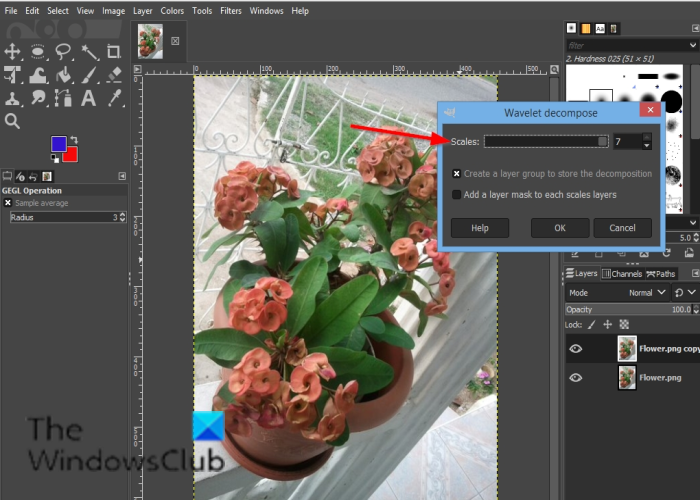
A Wavelet-decompose dialog box will open.
You can use the Scale slider or input box to increase scale fitness.
We hope this tutorial helps you understand how to use the Enhance filters in GIMP.
How do I enhance color in GIMP?
GIMP comes with a built-in Color Enhance feature that automatically enhances image colors to make it more beautiful. To use this feature, open an image in GIMP and click on the Colors menu. Access the Auto section in that menu and click on the Color Enhance option. This will process the image and colors will be enhanced.
If you have questions about the tutorial, let us know in the comments.
Leave a Reply